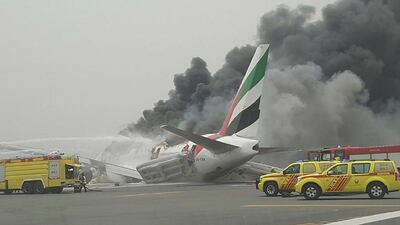Consider for a minute what you would do if you were caught inside a stricken airliner on the runway with smoke in the cabin and the flight crew urging you to evacuate as soon as possible. Would you immediately obey or would you take the time first to use your smartphone to record the scene for posterity?
Amateur footage from inside the aircraft that operated as Emirates Flight EK521 was posted almost immediately after last week’s crash at Dubai International Airport. It was picked up by global media outlets, inviting us to marvel at images of passengers reaching for their luggage before leaving.
These passengers were acting on a universal atavistic human instinct to secure personal possessions before leaving the sinking ship. But what about the motives for filming the passengers reaching for their luggage before leaving?
Think about it. The escape ramps are deployed. You are being directed to evacuate a smoke-filled aircraft. But you reach for your hand-held, presumably enter the pass code, scroll and select camera, then video, then press record. Try it yourself. How long does it take?
Whatever the motivation, how does personal safety come a distant second to the digital capture and dissemination of your predicament and that of those around you?
A few months ago in the cabin of a hijacked Egyptian airliner, a British man took time to ask whether the hijacker – who was wearing what was later discovered to be a fake suicide vest – would pose for a photograph.
The hijacker obliged and the image, taken by a member of the aircrew, was captured, posted and later described by its originator as the “best selfie ever”.
That episode reminded me of a telling scene in the Brad Pitt zombie blockbuster World War Z in which scenes of panic and carnage as the infected run amok are momentarily eclipsed by the silhouette of a hand holding up a smartphone. Major news outlets immediately send motorcycle riders to the scenes of death and destruction to gather from witnesses the inevitable hoard of smartphone photographs and video.
Digital displacement syndrome, as I call it, was also illustrated by tourists who returned to the scene of the massacre of 38 people on a Tunisian beach to take selfies. Extendable sticks were deployed for better group shots of holidaymakers positioned in front of the murder site, some of them smiling for the camera.
Digital displacement syndrome is the feeling, fostered by the ease with which every aspect of life can be digitally captured and posted, that the person generating the images is somehow removed from the circumstances and implications surrounding the events being depicted – much in the way that a movie director is disassociated from the cast he or she is filming.
Ordinary human interactions are subjected to the processes and protocols of digital media production and dissemination. The varied rituals of life at home, from cooking to applying make-up to dieting and fitness to family celebration and interaction, can cease to have meaning within their immediate human context and are instead produced, framed and shared as though they were plots in a movie destined for public consumption.
Many will be aware of the current trend, before sitting down for a meal with family and/or friends, of the host or chef capturing the prepared dishes on a smartphone for immediate release on Instagram. Meals thus become magazine photo shoots. Nobody can eat until the wider digital audience is first fed. Smartphones are repeatedly consulted during the meal to check on how many likes the warm goat’s cheese salad has earned.
This is all harmless enough, you might think. But the selfie culture often leaves people with the impression that they are actors playing a role, rather than normal people subject to the implications of human interactive cause and effect.
Life is thus not “real”. It is played out on a bogus digital stage where negative repercussions, should they arise, can simply be reshot or re-edited.
The EgyptAir hijacker, armed with what at the time was thought to be a bomb, was thus rendered an extra in a movie destined for friends and the wider digital community. Cause and effect, reality itself, was somehow negated by the mere presence of a smartphone.
I have written before for this newspaper about the negative effects of social media. My chief complaint was that such platforms can lead to the celebritisation of everyday life, to ultimate disillusionment and detachment from the implications of human interaction and to the subsequent devaluation of the concept of personal responsibility.
We live in real time, not just for posterity or notoriety. What we do in our immediate circumstances affects others for whom we are ultimately responsible.
Our addiction to digital capture – in the home, at work, in conditions of extreme distress or tragedy – can serve to devalue this truth.
Martin Newland is a former editor in chief of The National

